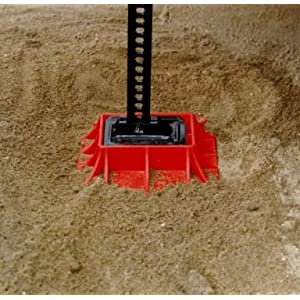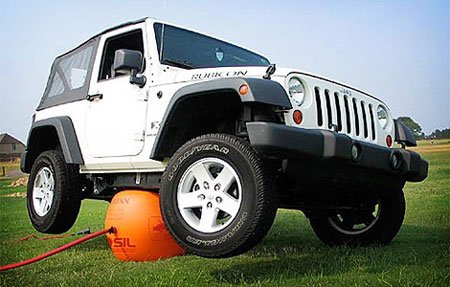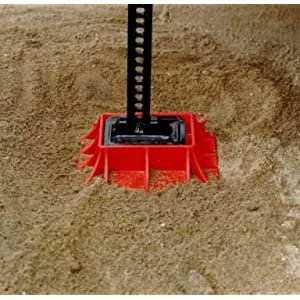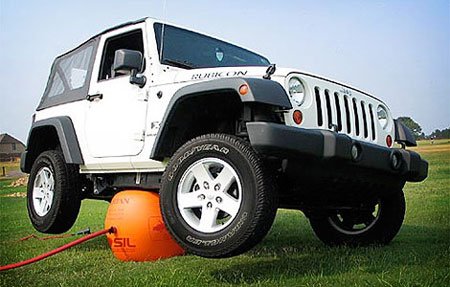frogslinger
Full Access Member
- Joined
- Mar 23, 2010
- Posts
- 1,072
- Reaction score
- 4
as requested by the big boss man here;
In the Lexicon of offroading there are few Items as useful or as feared as a Hi-Lift jack.
This tool is ubiquitous amongst serious offroaders for one reason; it is possibly the most versatile tool available to you in the boonies. It also has the ability to kill you.
The Hi-lift jack most obvious use is as a jack. They are designed simply for lifting, not supporting or stabalisation, so it is critical to chock tires and set brakes before using the jack. The base of the jack should be placed on a firm surface, or on an offroad base, large piece of wood or 1/4 inch or thicker metal. The jack can then be used to lift ONE wheel. Although the jack can lift more than one wheel, the resulting load will be extremely unstable and can shift, damaging the vehicle, the jack and injuring or killing the operator.
The Jacks key offers a few advantages whilst jacking... the lifting nose can be slid up and down to the desired position until a load is applied, speeding up the jacking process... the jack has a long handle that allows for torque multiplication... the jack can deal with vehicles with far larger than OE tires...
It does however have disadvantages... if used incorrectly the handle will swing under load with the force of a baseball bat... the jack is far larger and heavier than a conventional jack... the jack requires either special attachments or a solid point for jacking that may not be available on most modern vehicles.
The jack offers the advantage that it can be used as a clamp... depending on the model purchased the top of the jack can clam against the lifting nose, or an attachment can be bought to fill this requirement.
The with the jack reversed it can also be used as a spreader or Jaws of life, to extract trapped passengers from an overturned vehicle.
The main reason that I will always carry a Hi-Lift in a 4x4 is that it can double as a come-along or winch. With the addition of custom accesories or an Offroad Kit, the jack can leapfrog over itself without releasing tension pulling a load along the entire length of whatever chain is being used, unlike a come along that may need to be reset. Without the ORK the jack can still be used as a winch/come along, however it is far slower and tiring.
Couple of vids
http://www.youtube.com/watch?v=bOcQHqLx90g
http://www.youtube.com/watch?v=d9mqMTS8C_8
http://www.youtube.com/watch?v=Nlb32KFRD7I
In the Lexicon of offroading there are few Items as useful or as feared as a Hi-Lift jack.
This tool is ubiquitous amongst serious offroaders for one reason; it is possibly the most versatile tool available to you in the boonies. It also has the ability to kill you.
The Hi-lift jack most obvious use is as a jack. They are designed simply for lifting, not supporting or stabalisation, so it is critical to chock tires and set brakes before using the jack. The base of the jack should be placed on a firm surface, or on an offroad base, large piece of wood or 1/4 inch or thicker metal. The jack can then be used to lift ONE wheel. Although the jack can lift more than one wheel, the resulting load will be extremely unstable and can shift, damaging the vehicle, the jack and injuring or killing the operator.
The Jacks key offers a few advantages whilst jacking... the lifting nose can be slid up and down to the desired position until a load is applied, speeding up the jacking process... the jack has a long handle that allows for torque multiplication... the jack can deal with vehicles with far larger than OE tires...
It does however have disadvantages... if used incorrectly the handle will swing under load with the force of a baseball bat... the jack is far larger and heavier than a conventional jack... the jack requires either special attachments or a solid point for jacking that may not be available on most modern vehicles.
The jack offers the advantage that it can be used as a clamp... depending on the model purchased the top of the jack can clam against the lifting nose, or an attachment can be bought to fill this requirement.
The with the jack reversed it can also be used as a spreader or Jaws of life, to extract trapped passengers from an overturned vehicle.
The main reason that I will always carry a Hi-Lift in a 4x4 is that it can double as a come-along or winch. With the addition of custom accesories or an Offroad Kit, the jack can leapfrog over itself without releasing tension pulling a load along the entire length of whatever chain is being used, unlike a come along that may need to be reset. Without the ORK the jack can still be used as a winch/come along, however it is far slower and tiring.
Couple of vids
http://www.youtube.com/watch?v=bOcQHqLx90g
http://www.youtube.com/watch?v=d9mqMTS8C_8
http://www.youtube.com/watch?v=Nlb32KFRD7I






